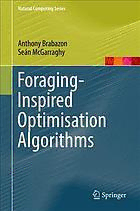Table Of ContentNatural Computing Series
Anthony Brabazon
Seán McGarraghy
Foraging-
Inspired
Optimisation
Algorithms
Natural Computing Series
SeriesEditors:G.Rozenberg
Th.Bäck A.E.Eiben J.N.Kok H.P.Spaink
LeidenCenterforNaturalComputing
Advisory Board: S. Amari G. Brassard K.A. De Jong C.C.A.M. Gielen
T. Head L. Kari L. Landweber T. Martinetz Z. Michalewicz M.C. Mozer
E. Oja G . Pa˘un J. Reif H. Rubin A. Salomaa M. Schoenauer
H.-P. Schwefel C. Torras D. Whitley E. Winfree J.M. Zurada
More information about this series at http://www.springer.com/series/4190
Anthony Brabazon • Seán McGarraghy
Foraging-Inspired
Optimisation Algorithms
Anthony Brabazon Seán McGarraghy
School of Business UCD Centre for Business Analytics
University College Dublin University College Dublin
Dublin, Ireland Dublin, Ireland
ISSN 1619-7127
Natural Computing Series
ISBN 978-3-319-59155-1 ISBN 978-3-319-59156-8 (eBook)
https://doi.org/10.1007/978-3-319-59156-8
Library of Congress Control Number: 2018957425
© Springer Nature Switzerland AG 2018
This work is subject to copyright. All rights are reserved by the Publisher, whether the whole or part
of the material is concerned, specifically the rights of translation, reprinting, reuse of illustrations,
recitation, broadcasting, reproduction on microfilms or in any other physical way, and transmission or
information storage and retrieval, electronic adaptation, computer software, or by similar or dissimilar
methodology now known or hereafter developed.
The use of general descriptive names, registered names, trademarks, service marks, etc. in this
publication does not imply, even in the absence of a specific statement, that such names are exempt
from the relevant protective laws and regulations and therefore free for general use.
The publisher, the authors and the editors are safe to assume that the advice and information in this
book are believed to be true and accurate at the date of publication. Neither the publisher nor the authors
or the editors give a warranty, express or implied, with respect to the material contained herein or for
any errors or omissions that may have been made. The publisher remains neutral with regard to
jurisdictional claims in published maps and institutional affiliations.
This Springer imprint is published by the registered company Springer Nature Switzerland AG
The registered company address is: Gewerbestrasse 11, 6330 Cham, Switzerland
To Maria,mymotherRose, andtothememoryofmyfatherKevin
Tony
ToMilena, Martinand Alex
Sea´n
Preface
In recent times there has been growing interest in biomimicry, or ‘learning from
nature’, with many disciplines turning to natural phenomena for inspiration as to
how to solve particular problems in their field. Examples include the development
ofpharmaceuticalproductsbasedonsubstancesfoundinplants,andinspirationfor
engineeringdesignsbasedonstructuresandmaterialsfoundinnature.
Anotherstrandof‘learningfromnature’concernsthedevelopmentofpowerful
computationalalgorithmswhose designis inspired bynaturalprocesseswhichim-
plicitly embed computation.Biologicallyinspired algorithmstake inspirationfrom
a wide array of natural processes, including evolution, the workings of the central
nervoussystem and the workingsof the immunesystem, in order to developalgo-
rithms for optimisation, classification, function approximationand other purposes.
The foraging activities of animals and other organismsare an additional source of
inspirationfor the design of computationalalgorithms.Foragingbehaviours,along
with some of the algorithmsthathave beendevelopedto date bydrawingon these
behaviours,formthefocusofthisbook.
The aim of foraging is to acquire valuable resources such as food, shelter and
mates.A practicalproblemisthatingeneralthe foragerdoesnotknowin advance
andwithcertaintythelocationofresourcesintheenvironment.Goodforagingstrate-
gies,therefore,needtoembedarobustsearchprocessbasedonsparseandnoisyin-
formation.Arichliteraturebasedontheforagingstrategiesofvariousorganismshas
beendevelopedincludingantcolonyalgorithms,honeybeealgorithmsandbacterial
foragingalgorithms,amongstothers.
Asyetthereisnounifyingtextwhichprovidescomprehensivecoverageacross
these algorithms. This book closes that gap. In addition to overviewing the main
familiesofoptimisationalgorithmswhichstem froma foragingmetaphor,wecon-
textualise these algorithms by introducing key concepts from foraging and related
literatures,andalsoidentifyopenresearchopportunities.
Thebookisdividedintosevenparts.PartIpresentsaseriesofperspectivesfrom
the literatures on foraging,sensory ecology and social learning which are relevant
foralgorithmicdesign.PartIIprovidesaframeworkforlaterchapters,byintroduc-
ing a number of taxonomies and a general metaframework which help categorise
VII
VIII Preface
thelargeliteratureonforaging-inspiredoptimisationalgorithms.PartsIIItoVintro-
duce a range of algorithmswhose inspirationis drawn fromthe foragingactivities
of vertebrates, invertebratesand nonneuronalorganismsrespectively. In Part VI, a
numberofalgorithmsareintroducedwhoseinspirationisdrawnfromformalmodels
offoragingoutlinedinPartI.Inthefinalchapterofthebook,weoutlinesomeopen
researchopportunities.
Wehopethatthisbookwillbeofinteresttoacademics,studentsandpractition-
erswhoareseekingadetaileddiscussionofthecurrentstateoftheartinforaging-
inspiredalgorithms.Particulartargetaudiencesincludethoseinterestedininformat-
ics,datascienceandmanagementscience.Thebookiswrittensoastobeaccessible
to a wide audience and no prior knowledge of foraging-inspired algorithms is as-
sumed.
Therichcomplexityofforaginginnature,anditscapabilitytoinspirealgorithmic
design,isatrulyfascinatingsubjectofstudy.Wehopethatyouenjoyyourjourney
throughthisbook.
AnthonyBrabazon
Sea´nMcGarraghy
Dublin,July2018
Acknowledgements
The inspiration for this text arose during the preparationof our last book, Natural
ComputingAlgorithms(alsopublishedbySpringer),inwhichweprovidedcoverage
of a wide array of computationalalgorithms whose metaphoricalroots come from
naturalphenomenainbiology,chemistryandphysics.Duringthatprojectitbecame
apparentthatwhileforaging-inspiredalgorithmsareasignificantfieldofresearchin
their own right, no unifyingtext existed concerningthem. As a result, the idea for
thisbookemerged.
As with all book projects, multiple people have contributed. We thank our re-
searchcolleaguesinthefieldfortheirgeneroussharingofideasthroughtheirpubli-
cationsandthroughdiscussionswehavehadwiththematconferencesandacademic
meetings.Wewouldalsoliketoacknowledgewiththanksthecontributionofmem-
bers (past and present) of the Natural Computing Research & Applications Group
atUniversityCollegeDublin(http://ncra.ucd.ie).Discussionswithourunder-
graduateandpostgraduatestudents,acrossarangeofmoduleswehavetaught,have
alsohelpedtomouldthematerialinthisbook.
We extendourthanksto RonanNugent,Senior Editorat Springer.His encour-
agementofthisprojectfromitsearlieststageshelpedensureitmovedbeyondan‘in-
terestingidea’toreality.Ronan’sinvaluableadviceonearlydraftsofthemanuscript
hasresultedinafarstrongerfinalbook.WewouldalsoliketonoteRonan’ssignifi-
cantcontributiontothefieldofnaturalcomputing.Hisknowledgeofkeythemesand
emergingtrendsinthefield,combinedwithhisencouragementofmultipleauthors,
hashelpedshapethedialoguewhichexistsinthefieldtoday.
Mostimportantly,weeachextendaspecialthankyoutoourfamilies.Youbear
the‘cost’intermsofthelatenightsandweekendswhichweredevotedtothewriting
ofthisbook.We eachthankourfamiliesforyourloveandunderstanding.Without
yoursupportthisbookwouldneverhavebeenwritten.
AnthonyBrabazon
Sea´nMcGarraghy
IX
Contents
1 Introduction................................................... 1
1.1 WhatDoesThisBookCover? ................................ 1
1.2 TheDiversityofLife........................................ 3
1.2.1 ForagingInteractions................................. 6
1.3 WhatIsForaging?.......................................... 7
1.4 ChoiceofForagingStrategy.................................. 7
1.5 PayoffsofForagingStrategies................................ 12
1.6 AlternativeApproachestoForaging ........................... 14
1.7 StructureofBook .......................................... 17
PartI PerspectivesonForaging
2 FormalModelsofForaging ..................................... 23
2.1 OptimalForagingTheory.................................... 23
2.1.1 OperationalisingOFT ................................ 24
2.1.2 StrandsofOFTLiterature ............................. 26
2.1.3 CritiquesofOFT .................................... 27
2.2 IdealFreeDistribution ...................................... 28
2.3 ForagingasaGame......................................... 28
2.3.1 Hawk–DoveGame................................... 30
2.3.2 Producer–ScroungerGame ............................ 31
2.4 Predator–PreyModels....................................... 31
2.5 MovementEcology......................................... 35
2.5.1 RandomWalkModelsofForagingMovement............ 35
2.5.2 Le´vyFlightForagingHypothesis....................... 35
2.5.3 FreeRangeandHomeRangeBehaviour................. 37
2.5.4 Navigation.......................................... 37
2.6 Networks ................................................. 42
2.6.1 ApplicationsofNetworkModels ....................... 42
2.6.2 BiologicalNetworksandAlgorithmicDesign ............ 42
XI
XII Contents
2.7 Summary ................................................. 44
3 SensoryModalities ............................................. 45
3.1 AnInternalModelofForaging ............................... 45
3.2 ThePerceptualWorld ....................................... 47
3.3 SensoryModes ............................................ 48
3.3.1 Vision.............................................. 50
3.3.2 Hearing ............................................ 53
3.3.3 Chemoreception ..................................... 54
3.3.4 Touch.............................................. 56
3.3.5 Electroreception ..................................... 57
3.3.6 Magnetoreception.................................... 58
3.3.7 MultisensoryCapabilities ............................. 59
3.4 CostofSensoryCapabilities ................................. 60
3.5 Summary ................................................. 62
4 IndividualandSocialLearning .................................. 65
4.1 Learning.................................................. 65
4.1.1 Memory............................................ 66
4.1.2 PredictiveModelling ................................. 68
4.2 SocialLearning ............................................ 69
4.2.1 IsSocialLearningAlwaysUseful? ..................... 72
4.2.2 SocialLearningStrategies............................. 73
4.2.3 SocialLearningStrategiesandOptimisationAlgorithms ... 74
4.3 OptimalLevelofLearning................................... 75
4.4 SocialForaging ............................................ 77
4.4.1 WhyWouldSocialForagingArise?..................... 77
4.4.2 AggregationandDispersionEconomies ................. 78
4.4.3 InfluenceofSocialSettingonIndividualBehaviour ....... 79
4.5 CommunicatingInformationAboutResources .................. 80
4.6 Summary ................................................. 82
PartII Foraging-InspiredAlgorithmsforOptimisation
5 IntroductiontoForaging-InspiredAlgorithms..................... 87
5.1 CharacterisinganOptimisationProblem ....................... 87
5.2 CategorisingForaging-InspiredAlgorithms..................... 89
5.2.1 TreeofLife......................................... 90
5.2.2 ForagingCapabilities................................. 91
5.2.3 SensoryMechanisms ................................. 91
5.2.4 MemoryMechanisms................................. 92
5.2.5 LearningandCommunicationMechanisms .............. 93
5.2.6 StochasticComponentofForagingProcess .............. 95
5.3 AMetaframeworkforForaging-InspiredAlgorithmDesign ....... 98

